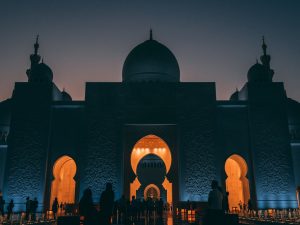
Faculty of Tarbiyah and Teacher Training – Who would have thought that Gus Dur, KH Abdurrahman Wahid, would become Indonesia’s fourth president? At that time, people were shocked and couldn’t believe it, you know. But, what’s sad is that the democratic way he was elected was undermined by the unconstitutional way he was ousted.
So, now exactly 22 years ago, July 23 2001, the pious figure who was respected by everyone in this country stepped down from his presidency. For him, there is no position that should be defended vigorously. So, he was willing to leave the Palace so that there would be no bloodshed. So guys, Alma Ata University can be a forum for studying Islamic religious education.
You can see 5 book recommendations about Gus Dur from the five books below. These books give a different perspective on Gus Dur’s journey to lead our beautiful country, you know.
Here are 5 recommended books about Gus Dur:
1. Gus Dur’s Last Days at the People’s Palace
This book is the work of a senior journalist named Andreas Harsono. In his book, Andreas explores the process of KH Abdurrahman Wahid’s decline from the perspective of media reporting. Even though the book is thin, the content in it is quite complete in analyzing how the media reported Gus Dur. There are two perspectives that we can look at from this book, namely (1) how the media reports Gus Dur and (2) how the media depicts Gus Dur.
The beginning of this book discusses the inauguration of National Police Chief Chairuddin Ismail who replaced Bimantoro on July 20 2001. Then, this book explains the MPR Plenary Meeting, the meeting in Kebagusan, the Troop Degree ceremony at Monas, the meeting at the Ministry of Defense, and the announcement of the President’s “Decree”.
All of these discussions were analyzed in depth by Andreas from a journalism perspective. Apart from that, Andreas also added three additional chapters at the back of the book, namely regarding the Speed of Mass Media Coverage, Debates in Selecting Sources, and News Accuracy. In the last three chapters, he examines journalistic problems that arise in reporting about KH Abdurrahman Wahid.
2. Last Days with Gus Dur
This book is a story about the journey of the author, Bondan Gunawan, with Gus Dur. They both attempted to carry out reforms through the Democracy Forum (Fordem). Apart from that, Bondan was also Minister of State Secretary (Mensesneg) in the National Unity Cabinet government from 15 February to 29 May 2000.
In his book, Bondan tells the story of their journey with Gus Dur, starting from when he was outside the government, while in government with KH Abdurrahman Wahid, until after KH Abdurrahman Wahid was no longer in office. He described the trip in great detail as someone close to Gus Dur. His writing is not only based on document data, but also personal experiences he had with Gus Dur.
3. Gus Dur’s Political Journey
Very different from the two previous books, this book discusses Gus Dur’s adventures in the world of Indonesian politics. This book is divided into three parts, the first discusses Politician Politics, Ulama Politics; the second discusses the Santri President; and the third discussed Buloggate, Decree, and Returning to Ciganjur.
In the first chapter, Gus Dur’s journey to becoming president is discussed, starting from asking for blessings from famous kiai until finally becoming the number one person in Indonesia. In this chapter, there are interesting writings from various people, ranging from political experts, experts from Islamic campuses, journalists, to kiai.
So, in the second chapter, we explain how KH Abdurrahman Wahid led as president. The authors discuss it from various angles, from KH Abdurrahman Wahid’s past as a student and kiai, to his policies in all fields, such as politics, economics, to foreign diplomacy. In the last part of the book, there is a story of Gus Dur’s political friction with his enemies. The fistfights increased, and finally he returned to Ciganjur.
4. The Indonesian People Sue KH Abdurrahman Wahid
This book contains news from various mass media information systems which display a negative view of KH Abdurrahman Wahid’s leadership. This collection of writings was collected by Arsyil A’la Al-Maududi and published in October 2000.
There are nine parts in this book published by Wihdah Press, namely (1) KH Abdurrahman Wahid, Aceh, Ambon, and CSIS; (2) KH Abdurrahman Wahid, Buloggate, and Bruneigate; (3) Gus Dur, Suharto, KKN, and so on; (4) Gus Dur, PKB, NU, and Communism; (5) KH Abdurrahman Wahid in Ruwatan Rituals and the Problem of Musyrik; (6) Gus Dur and Ariyanti; (7) Gus Dur Travels Abroad; (8) Internet Community Assessment of Gus Dur; and (9) Gus Dur in the World of Cybernews.
All information systems writings contained in this book have a negative tone. None of the news collected in this book has a positive or even neutral view. The facts and sources presented in all the news in this book are clearly intended to portray Gus Dur’s leadership in a bad light. In fact, it is not only a matter of leadership and political style, but also aspects
5. Gus Dur shook President Abdurrahman Wahid
This book, like book number four, also contains writings that are negative and light on KH Abdurrahman Wahid’s leadership in Indonesia. This book was published by the Amar Ma’ruf Nahi Munkar Foundation when Gus Dur was still president. The difference with the fourth book is that this book contains opinions and interviews from figures who are politically opposed to Gus Dur.
The first article presented was entitled “President KH Abdurrahman Wahid as a Source of Conflict.” Azyumardi Azra wrote this referring to the dismissal of several presidential aides. He also criticized Gus Dur for forgetting that his government was formed based on a coalition of political parties, and for not having a clear framework and concept. This article requires further investigation to ensure its correctness because the book does not explain the sources used.
Apart from writings from the figures, this book also contains a number of interviews with them regarding the figure of Gus Dur which were published in various media, such as the Justice Forum and Tempo magazine. For example, Adi Sasono, Minister of Cooperatives under President Habibie, criticized KH Abdurrahman Wahid in an interview with the Justice Forum without including solid data. Amien Rais also made a similar statement in an interview with the same magazine and Tempo magazine. In fact, Amien described the president as a student in his interview.
This book collects various accusations against Gus Dur contained in interviews and writings that tend to demean Indonesia’s fourth president. Gus Dur’s actions as president were considered a wrong step with nothing right in their view.
Source:
- https://www.nu.or.id/pustaka/5-rekomendasi-buku-tentang-gus-dur-dan-politik-1l2VP
- https://www.freepik.com/free-vector/gradient-glossary-illustration_40126588.htm#query=Ilustrasikan%20beberapa%20buku&position=6&from_view=search&track=ais&uuid=22dce739-031b-4cf1-8a8f-a17679cdee57








